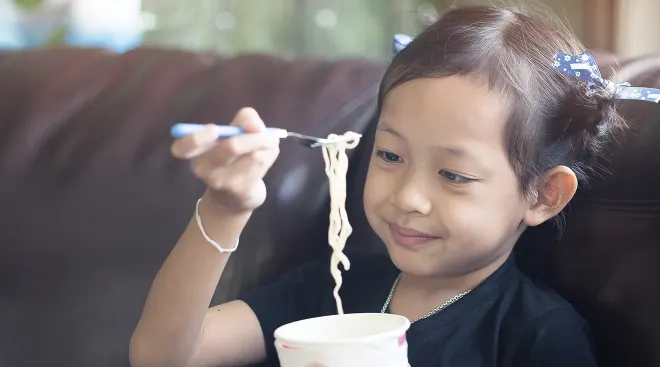This Food is Responsible for Nearly a Third of All Kids’ Burns

When you have little tykes running around the house and playing outside, it’s just not possible to always be everywhere at once and avoid something going awry. From broken bones to boo-boos and burns, a new study helps parents identify a popular culprit when it comes to childhood burns so parents and pediatricians can work together to prevent burns.
Recently published in an international medical journal burns, Doctors at the University of Chicago Medical Center analyzed thousands of cases of childhood burns to find the most common cause. Learn more about what they found and how to protect your child below.
What the Study Found
Taking data from hospitals from 2010 to 2020, researchers found that of the 790 cases they reviewed, 31 percent or nearly one-third of children’s scald injuries were caused by instant noodles. Scald injuries, which are burns caused by hot liquids, can happen to anyone, but the risk of serious second- and third-degree burns for children is higher because of their relatively smaller bodies and thinner skin. skin An estimated 100,000 children suffer burns from food and drink in the United States each year.
An inexpensive, easily prepared microwave food, Instant Noodles, which contains a starchy liquid in its solid ingredients, has been shown to lead to different burn patterns than hot water alone. According to University of Chicago researchers, while less severe than some other types of scald burns, instant noodle injuries are still dangerous, leading to burns that sometimes require hospitalization, surgery or skin grafting.
“Anecdotally, it seems like every other child who consults us for a burn has been injured by instant noodles, so we wanted to dive into the data to see what the trend really is,” senior study author and assistant professor of surgery at UChicago Medicine. Sebastian Vrouwe, MD, told a press release. “Our hope is to form the basis for a future burn prevention program, because all childhood burns are preventable in some way.”
How Children’s Burns Often Happen
While the study itself did not explore the exact incidence of instant noodle burn injuries, Vrouwe said the burn team saw common patterns such as accidental spills when removing containers from the microwave. , including spills while eating due to the narrow base of the instant noodle cups. .
“We were surprised by the magnitude of the problem, which confirmed that focused effort and awareness of these types of burns can have a significant impact on the communities served by our burn center,” he said.
Four Tips for Preventing Burns
While accidents do happen, Vrouwe offers these four tips to help prevent scald burns.
- Manage meal times. While parents are not always around, try to watch mealtimes if possible. According to the study, 40 percent of instant noodle burns occurred when children were reported to be alone at the time of the injury.
- Remove hot items from the microwave for your children. Spills can easily happen when taking thin noodle cups out of the microwave. Be sure to remove hot liquids from the microwave and wait until they cool enough before giving them to your child.
- Eat at the table. Make sure hot liquids are placed on a stable surface. Eating at the table instead of on the lap helps reduce the risk of burnout.
- Lower the temperature of your hot water heater. Turning hot water heaters down to 120 degrees Fahrenheit is an established method to prevent burns in the home.
Looking for more tips on keeping your child safe? Check out this comprehensive list of baby safety tips from car seat safety to sunscreen recommendations.
Please note: The Bump and the materials and information it contains are not intended to, and do not constitute, medical or other health advice or diagnosis and should not be used as such. You should always consult a qualified physician or health professional regarding your specific circumstances.





